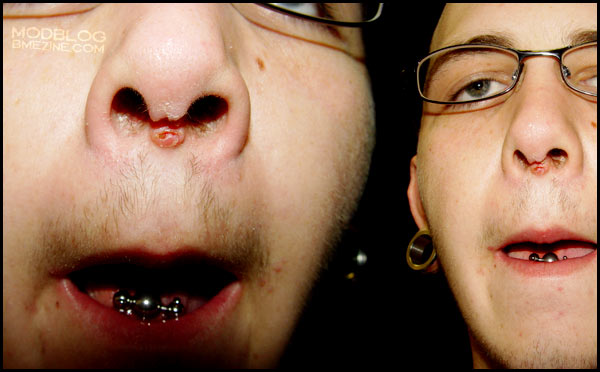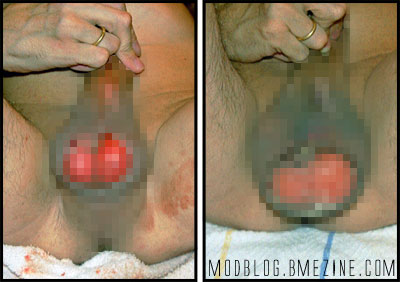Well, let’s rephrase that for the folks who are like, “cool, a free meatotomy” — what do you do when your PA tears out and you wish it hadn’t? I didn’t ask Chrom (from Hell in Prague) how it happened — he just writes, “bloody mishap!” — but you can see it here torn [1], being prepped for a re-stitch [2], stitching complete [3], and right after the stitches were removed [4].
Tag Archives: risks
Post navigation
Ouch… the uninostril dude…
Hot Balls! Don’t drop them!
You may have seen these in the weekend’s BME/HARD update, but because Phil doesn’t read German I don’t think the explanation was posted.
‘J’ had a rather nasty injury when a CBT game went too far — after tying off his nuts, he temporarily immersed them in boiling water. Unfortunately it was a bit much, and the skin was badly burned, leaving him with an open scrotum — it took nearly three months to heal. He’s fine, but I think will definitely set a lower time limit for nut roasts!
Transdermals can be trouble
An active lifestyle will probably make your life longer, but the counterpoint is that it’ll make your piercings’ and implants’ lives shorter… Tiff says that’s exactly what led to the demise of her paired transdermals — you can see how far they’d rejected in the first two shots. Tom Brazda (TomBrazda.com — he also removed my magnets) removed them for her while he was guest spotting at Eternal Ink in Sheffield, UK.
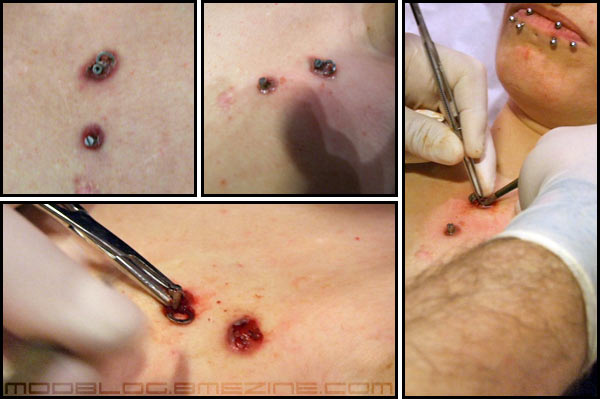
When life gives you lemons
Bring those lemons on down to Manny in San Bernardo, Argentina and make yourself some lemonade! (See also: Cheesecutter Effect).
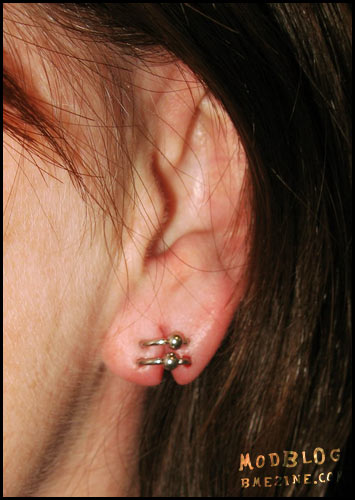
More than one way to skin a cat!
So you may remember that a few days ago I posted a very radical transdermal strip removal that involved a very large amount of tissue being removed, with the motivating factor being dealing with large bald spots that had formed around the transdermals. Anyway, it created quite the furor in the entry, with many people feeling that too much tissue had been removed. Now, personally, I actually didn’t think it was all that bad a method, but in fairness I think it’s also important to post what more conservative practitioners felt a safer removal would be.
Steve Truitt just took out J5th‘s top transdermal (five years old) and he wanted me to show that the removals can be done far less invasively… What’s funny is when he took it out, it was all bent! I guess he took a blow to the head some time ago and didn’t even know it had damaged the transdermal! Apparently he has a hard head.
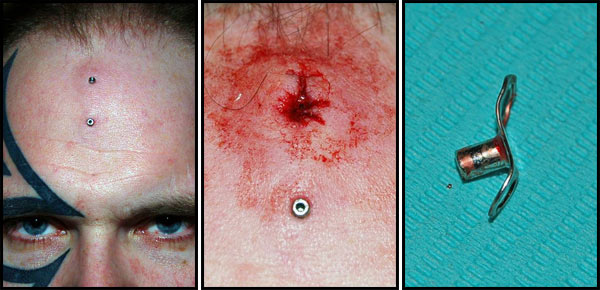
In terms of relating this to the larger removal posted earlier, this method would not address the baldspots of course and I believe has slightly more potential for scarring (assuming good healing in both cases), but it does involve hugely less risk to the client and practitioner and there’s a lot to be said for not risking seriously injuring your friends. The one above is fresh, and a smaller transdermal design, so let me also share the removal that Steve did on _Stigmata_, since I have a healed shot of that:
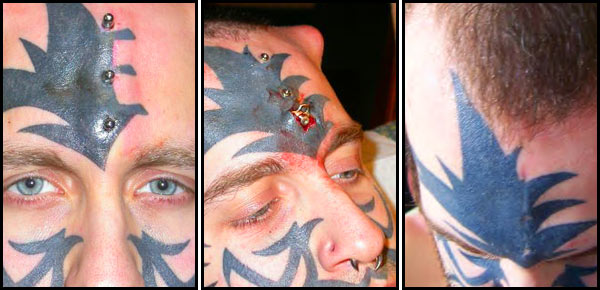
Anyway, bring on the yelling about it all. 🙂
Is Body Jewelry Quality Important?
This is a new section that I’m adding to ModBlog in which we talk to some of the best artists around the world about the nuances of the business of being not just good at what you do, but great. In this first column, we’ll be talking about jewelry — does it really make a difference if you’re using generic “316LVM” versus something that’s “ASTM-spec”? Is titanium really better? Is threading important? What if someone brings in their own jewelry?
I thought this would be a good one to start with, given the recent example of the kid who thought chain links would make acceptable jewelry!
In today’s column, commentary comes from (shown left to right below), Patrick Bartholomew (a mostly retired piercing pioneer who you may know from the London Piercing Clinic, and can be found at iam:PatrickB), Tom Brazda (iam:TomBrazda, TomBrazda.com, former owner and head piercer of Stainless Studios, now doing research and development into new body modification technologies and aftercare at BodyArt Pro), “Moddoctor” (iam:Moddoctor (a practising physician in the United States that is primarily a cosmetic surgeon but who also does piercing), and Leo Ziebol (iam:5point, co-owner of 5pointstudios)

PATRICK BARTHOLOMEW:
After fighting a running battle with rejection from allergies to stainless steel jewellery I finally stopped using it in fresh piercings on the first of January, 1992. I changed to titanium, and I have stayed with it ever since. With the steel I would have an average problem factor with rejection as high as twenty percent of all piercings, either minor “walking” out of alignment, or full rejection — with the Titanium it reduced to less than one piercing in four thousand. That was good enough for me. I also insist on supplying the initial jewellery.
TOM BRAZDA:
ASTM complient materials are designed to survive inside the human body and also release little to no toxic elements. These standards are changed as new information comes to light. If it does not comply with these standards then its considered a “commercial” grade material.
But material alone does not make a good piece of jewelry — you need a good smooth surface finish since the surface of the jewelry is what will be in contact with the healing tissue. If it’s not truly smooth it will increase scarring during the healing process by abrading the tissue as it moves around. The balls on the jewelry whether, it’s a barbell or captive need to be held on well and not come loose easily. The edges of the ring or barbell need to be rounded and smooth as well so that there is no sharp edge being pushed against the tissue.
The internal/external issue is a tough one since I’ve seen crappily made internals and well thought out externals. Whats important is what is in contact with the tissue during a jewelry insertion. Any sharp edge will cause damage.
Titanium is better in the sense that the tissue growth around it is not as dense as the tissue that forms around stainless, and since it’s lighter it’s better in heavier gauge piercings. But there are people out there that are sensitive to titanium, just like there are people sensitive to nickel. What makes the biggest difference is how “passive” the surface layer of the jewelry is. This can be achieved well in both stainless and titanium with proper processing.
Finally, if a customer brings in a piece of jewelry, unless I know who made the jewelry, I won’t use it. Most of the time its not even an appropriate size to do that persons piercing. People don’t come in standard sizes so “standard” sized jewelry doesn’t work!
MODDOCTOR:
It’s pretty remarkable how little difference jewelry material often makes. People with no metal sensitivities can heal with anything it seems. You could pierce those people with a paperclip (not really!) and they would do fine. Other people, though, just refuse to heal with stainless jewelry and I have found that changing to titanium resolves those problems. That said, jewelry quality makes a big difference across the board. Cheap jewelry seems like it sticks in a healing piercing, which may be the result of less than smooth polished surfaces.
As for internal versus externally threaded, I definitely prefer using internally threaded. It’s easier to pass through a fresh piercing and jewelry changes are less traumatic even in a well healed hole.
LEO ZIEBOL:
When it comes to jewelry, I don’t know much about how different metal affect the body on a cellular level but I do know that I want to do everything I can to help that piercing heal as easily as possible. I have seen a lot of problems associated directly to poor jewelry. I’ve also seen some of the most god-aweful pieces of reconstituted tin can heal excellently. For me, using quality jewelry is another way that I minimize the chance factor. I will never eliminate it but I will do my best to keep it as low as possible.
It is rare that I will use jewelry brought in by a client. We have one other shop in our area that uses ASTM internals and I would gladly use a piece that was brought in from there as long as it wasn’t damaged or of improper size for that client. If I don’t know where it came from or what company made it, I won’t use it.
So… Four experienced piercers, one a piercing pioneer, and one a doctor, all appear to be in general agreement — not only is it important to seek out not only jewelry made of high quality materials that are inherently biocompatible, but that the finish of the jewelry is of equal importance (so even if jewelry is a good material, if it’s not well manufactured, it will still complicate thing). All quality studios should be able to tell you exactly what materials they are putting in you and who manufactured them. You may pay a little more, but really, would you rather pay $25 for a piercing that’s going to be irritated, take longer to heal, and potentially reject, or $50 for one with a solid shot of lasting a lifetime?
In the next installment of this column we’ll be talking about items a good studio should have, that too few people have gone to the effort to obtain.
Chain Link Piercings Gone Bad (Well, Duh!)
So the fifteen year old DIY-piercer in this photo came in to Color Works in West Des Moines, Iowa with their mother after their doctor refused to help with the problem he’d caused. He’d decided to do the piercings himself — a pair of lip rings and a septum — using, and I kid you not, pieces of chain link that he’d clipped off with wire cutters. They weren’t pierced in place — they were just “crushed” in place with a pair of pliers and brutally crimped into his flesh!
Evan removed them (and one was even rusted), cleaned him up, and told him to go back to the doctor. While Evan was dealing with the problem, the kid refused to stop touching the problem areas no matter how much he was told, and his mother let his four little brothers and sisters come running into the piercing room from the lobby, upon which the one kid immediately starts going through the garbage. Jarret (who took the photos) got them under control as the mother told him about how she’d tried to cut the piercings out with scissors. Darwin Award anyone?
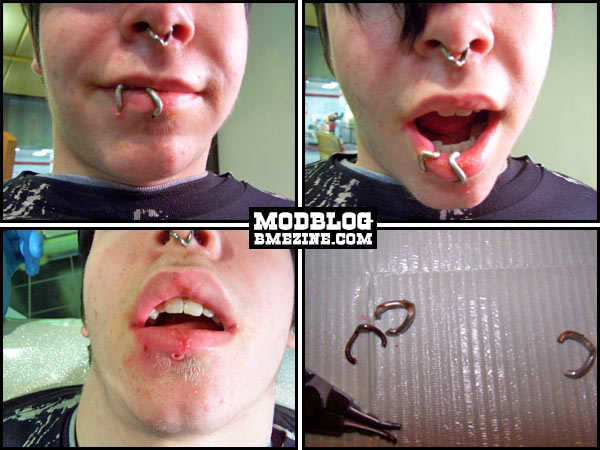
Seriously, this is why in my opinion laws need to allow young people to get body piercings. “18+” and “16+” laws do nothing but hurt young people. Doctors don’t give a fuck and don’t know what they’re talking about most of the time and are so constrained by liability insurance that they often can’t help even if they want to, parents are clueless, and there are plenty of fly-by-night shops and nomadic piercers willing to abuse pierce kids anyway… High quality shops need to be accessible to people of all ages, because the fact is, people of all ages want piercings, and they’ll get them one way or another.
Polymethyl methacrylate reaction
One of the most common and least expensive kind of jewelry is acrylic plugs (ie. “Lucite”, “Plexiglas”, etc.). In general it’s quite biocompatible (some contact lenses are made of it, dentures can be made of it, as can some types of bone cement)… That said, some people do react — James Raimar (Holey Body, Saginaw MI) sends in this shot of someone who came into his shop seeking help due to their body not liking the plastic jewelry one bit! He’s seen enough of these reactions that he recommends avoiding it.
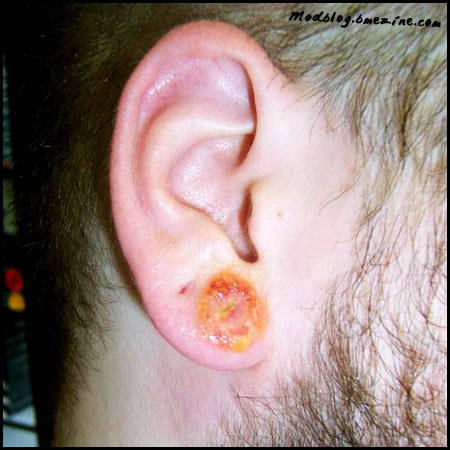
Transdermal Strip Removal
It’s certainly not unusual for transdermals to go bad (and I’ll even go so far as to propose that most will eventually fail and need removal), but this is definitely one of the most aggressive removals I’ve seen. That said, I have to admit that the stitched up version looks pretty happy in comparison to most mutli-transdermal removals. Procedure (but not the original transdermals) by Howie/Lunacobra.
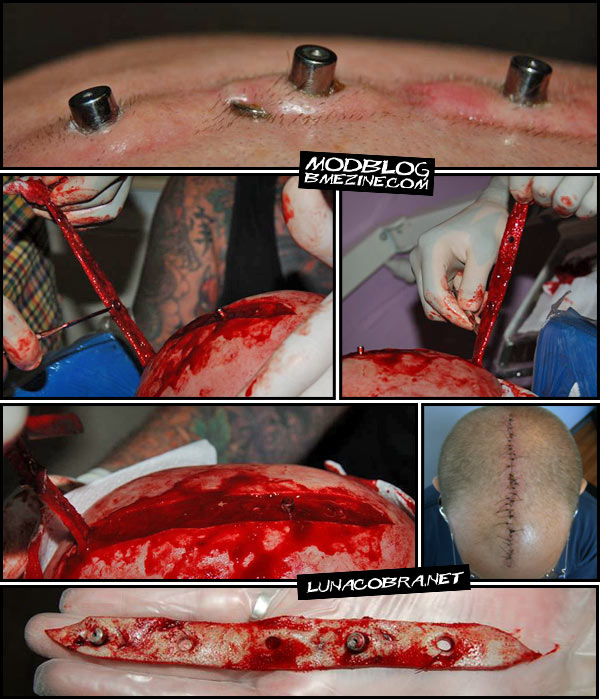
I know I say this all the time, but seriously — any modification you get, be prepared to eventually remove it or worse. That doesn’t mean don’t do it… just understand the risks involved and decide whether it’s worth it for you… Nothing is guaranteed to last forever, and in fact, most things are guaranteed not to last forever.

